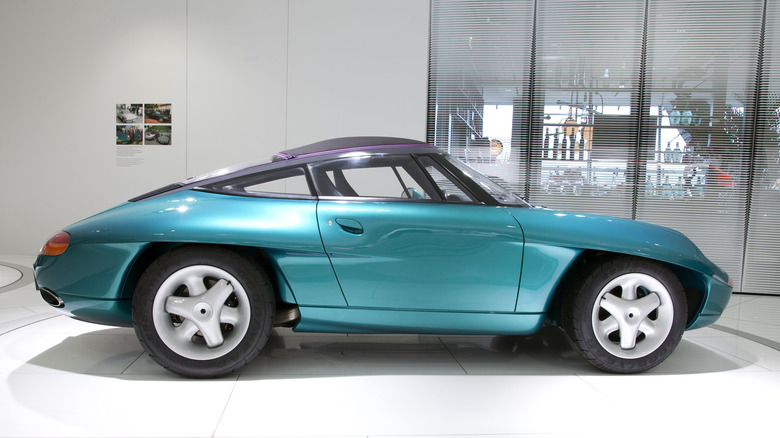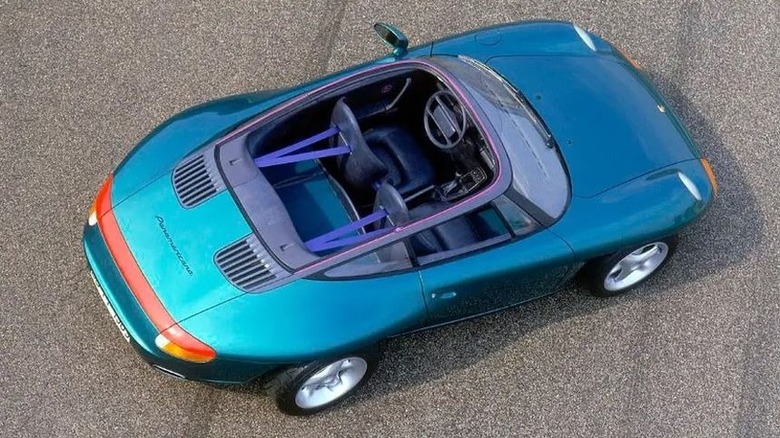The Panamericana Is The Strangest Porsche Concept Ever Built
The Cayenne may have been the first production SUV Porsche churned out in 2002, but it wasn't the first off-road Porsche created. That distinction goes to the Panamericana, a concept SUV the company built as a gift for Ferry Porsche's 80th birthday in 1989.
It's might seem an odd gift for an octogenarian, but it was meant more as an idea for what the future of Porsche could be as opposed to something the man would actually drive. Essentially, it looks like a 911 mated with a dune buggy, and that's exactly what Porsche was going for.
The initial technical aspects of the vehicle came from Dr. Ulrich Bez, head of development at Porsche at the time. Bez would go on to design the Porsche 993, head the department at BMW that came up with the Z-series, and become CEO of Aston Martin. Harm Lagaay, known for his work on BMW's Z1, commissioned the project and asked his design team to submit drafts of the concept 911 SUV. The final draft came from Steve Murkett, who would later work on two other projects at Porsche, the Cayenne, and Panamera.
Interestingly, the car's name was inspired by a Mexican road race that was part Le Mans endurance run, part Dakar Rally, and all Cannonball Run. "La Carrera Panamericana" took place on Mexico's open, public roads, with one simple rule: the first car to cross the finish line won.
Danger is Panamericana's middle name
"La Carrera Panamericana" was first run in 1950 to celebrate the opening of the new Pan-American Highway, which stretched some 19,000 miles from Alaska to Argentina. Mexico's part wound 3,350 miles from Nuevo Laredo, Mexico, to Panama City. However, the race was a nine-stage, five-day, roughly 2,100 mile race from Ciudad Juarez to Ciudad Cuauhtemoc, with elevation changes going from 328 to 10,482 feet.
The inaugural race only allowed sedans, but starting in 1951, it opened up to sports cars. Porsche excelled, grabbing stage wins in six of the top seven places in the small sports car category and coming in third overall in 1954 with its 550 Spyder, which it first unveiled the year before.
In fact, Porsche's success in the 1954 race is where the term "Carrera engine" originated (via Porsche). While "Carrera," which means both "race" and "career" in Spanish, it is now synonymous with the Porsche brand, although it didn't first appear in the name of one of its cars until the 356 A 1500 GS Carrera in 1956.
The Panamericana quickly became known as one of the most dangerous races in the world and was canceled after 1954, because of the hazards inherent in racing on public roads. More than half of the racers never crossed the finish line, and (depending on the source) between 24 and 27 people died (primarily bystanders and spectators).
The converted 964 Carrera Cabriolet off roader
Porsche wanted to harken back to those endurance racing glory days with the Panamericana, and it only took six months to create the concept car. It started with the chassis from a 964 Carrera Cabriolet with all-wheel-drive. Designers slapped on a jade green experimental body made of carbon fiber-reinforced polymer, and cut off the fenders to allow for a longer travel suspension and beefy, knobby off-road tires (with the Porsche badge etched into the rubber, mind you).
The prototype roof was split into three sections: The material section directly above the front seats could be removed with purple zippers, a color that would run throughout the interior of the car, and two plastic jade-colored bubble sections that sat directly underneath the roof material to keep it from sagging down onto the occupant's head. The rear windscreen section simply lifts out as one unit. Some of the roof's design elements found their way into the Boxster (via 9WERKS TV).
The concept was powered by the same 3.6-liter flat-six with 247 hp and 230 lb-ft of torque found in the 964 Cabriolet (via Top Gear). Many features (from the headlights to the roof line to the tail lights and exhaust) would appear in future Porsches (via Top Gear).
The Panamericana was first seen at the 1989 International Motor Show in Frankfurt, Germany, and wowed both critics and the attending audience. According to Stuttcars, two were made: One for Ferry Porsche and the other for the car shows. Furthermore, it's said that employees at Porsche at the time received a replica model (1:43-scale) mounted on a bronze plaque, apparently worth a pretty penny today.

